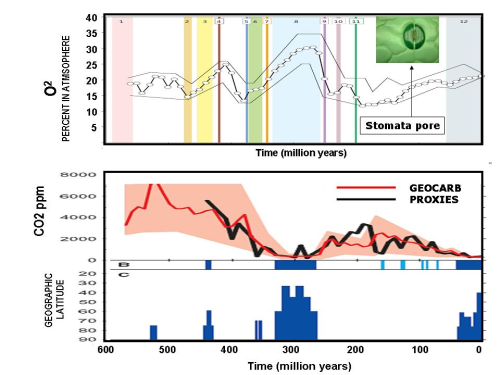The development of agriculture and thereby human civilisation had to wait until climate stabilised about 8,000 years ago, when large scale irrigation along the great river valleys (the Nile, Euphrates, Hindus and Yellow River) became possible.
Since the industrial revolution humans dug, pumped and burnt more than 320 billion tons of carbon which accumulated as the result of biological activity during 400 million years: 320 billion tons of carbon is more than 50 per cent the carbon concentration of the original atmosphere (540 billion tons). As a consequence the level of CO2 in the atmosphere has risen by about 40 per cent, from 280 to 388ppm.
The world is now witnessing a dangerous shift in the state of the atmosphere-ocean system, an extremely rapid change from the interglacial condition of the Holocene, which began about 11,700 years-ago, to conditions analogous to those of the mid-Pliocene when mean global temperatures were 2 to 3 degrees C higher, and sea levels about 25+/-12 meters higher, than the early 20th century.
Advertisement
In terms of the combined effects of CO2, methane and nitric oxide, the rise of greenhouse gases has reached about 460ppm CO2-equivalent (CO2-e) (Figure 1), only slightly below the 500ppm level which correlates with the maximum stability of the Antarctic ice sheet.
The current rate at which CO2 is rising, 2ppm per year, is unprecedented in the recent history of the Earth, with the exception of the onset of greenhouse atmospheric conditions following major volcanic episodes and asteroid and comet impacts, which led to the large mass extinctions in the history of the Earth (end-Ordovician, end-Devonian, end-Permian and Permian-Triassic boundary, end-Triassic, end-Jurassic, end-Cretaceous) (Figure 2).

Figure 2
Variations in atmospheric CO2 concentrations and oxygen concentrations correlated with ice ages (blue histograms, extending according to geographic latitude). Note the sharp decline in atmospheric CO2 during ice ages.
After Royer et al. 2004 (CO2 as a primary driver of Phanerozoic climate. GSA Today; v. 14; no. 3) and Berner et al. 2007.
Further rise of CO2-e above 500ppm and mean global temperatures above 4 degrees C can only lead toward greenhouse Earth conditions such as existed during the Cretaceous and early Cenozoic (Figure 2).
At 4 degrees C advanced to total melting of the Greenland and Antarctic ice sheets leads to sea levels tens of meters higher than at present.
Advertisement
Since the 18th century mean global temperature has risen by about 0.8 degrees C. Another 0.5 degrees C is masked by industrial-emitted aerosols (SO2), and further rise ensues from current melting of the ice sheets and sea ice, with loss of reflection (albedo) of ice and gain in infrared absorption by open water, leading to feedback effects.
The polar regions, acting as the “thermostats” of the Earth, are the source of the cold air current vortices and the cold ocean currents, such as the Humboldt and California current, which keep the Earth’s overall temperature balance, much as the blood stream regulates the body’s temperature and the supply of oxygen.
Unfortunately climate change is not an abstract notion, with consequences manifest around the globe in terms of:
Discuss in our Forums
See what other readers are saying about this article!
Click here to read & post comments.
43 posts so far.